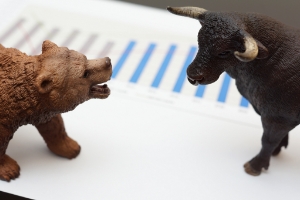 We are now in another downswing in the ongoing bear market. Using the S&P 500 as a measure, as I write this the markets are down 22 percent from the peak at the end of last year and just under 14 percent from the end of the most recent rally in August. This year, there have been four drops and three rallies—and we are down quite a bit. That doesn’t feel good. But, feel good or not, here we are. So, the real question is: what should we do about it? To figure that out, we need to look at two things.
We are now in another downswing in the ongoing bear market. Using the S&P 500 as a measure, as I write this the markets are down 22 percent from the peak at the end of last year and just under 14 percent from the end of the most recent rally in August. This year, there have been four drops and three rallies—and we are down quite a bit. That doesn’t feel good. But, feel good or not, here we are. So, the real question is: what should we do about it? To figure that out, we need to look at two things.
First, let’s look at history. Have we seen this before? Is the current pullback unusual, or is it fairly typical? If it looks pretty normal, that in itself is reassuring. History doesn’t repeat itself, but it does tend to rhyme. And history can give us an idea of how the song is likely to go. Second, why is this happening? Is there a reason that we can understand behind all of this? If there is a reason, then that understanding provides a basis for looking to the next steps.
Have We Seen This Before?
In the broader sense, yes, many times. Bear markets (declines of more than 20 percent) are typical enough that, as noted, they actually have a name. Looking back to 1980, there has been a decline of 20 percent or more in 9 of the 42 years, or about every 5 years. For 15 percent declines, that turns into 16 of 42 years, or about every 2 to 3 years. Significant declines are a regular and recurring feature of the stock market. In that context, this one is no different. And since it is no different, then like every other decline, we can reasonably expect the markets to bounce back at some point.
Why Is This Happening?
Although history is on our side, we still need to understand why this decline is happening. The primary reason is rising interest rates. There is an old Wall Street saying, “don’t fight the Fed,” which basically asserts that when the Fed is raising rates, the market will have a tough time. Just as the phrase bear market speaks to how normal the phenomenon is (normal enough to have a name), this too is normal enough to have a catchphrase associated with it. Not only the drawback itself but also the reason behind it are normal—and things we have seen before.
That answers the questions we started with. Yes, this pullback, although scary, is normal and something we have seen many times before. And, yes, we know why the market is pulling back, and again it is normal and makes sense. Given those two conclusions, we can think about what comes next.
What Comes Next?
When we look at the primary cause of the pullback (i.e., inflation and the consequent Fed tightening of interest rates), we see reasons for both caution and hope. The Fed has committed to raising rates until inflation is brought under control, which is what sparked the current renewed downturn and is a reason for caution. We can expect continued market turbulence for some time. But when inflation does pull back, that will open the door to sustained growth and market gains, as we have seen many times in the past decades. The Fed is performing surgery right now on the economy. In the short run, it is painful. But in the long run? It is a healing process and one that sets the stage for a healthier economy and markets. Again, we have seen this before.
Not All Bad News?
Even in the short term, despite the pain, it is not all bad news. Higher rates offer much better returns for savers, who can finally get a decent risk-free return. For those who are still putting money aside, a bear market gives a chance to buy stocks on sale, potentially leading to better future returns when it recovers. And, as always, a bear market gives investors a chance to take a good hard look at their portfolios and find out if they are really comfortable with the risk they are taking. The pain is real, but there are some positive side effects.
That is where we are. The Fed is in the middle of a painful policy change, but that change will lead to a healthier economy and stronger future growth. A bear market offers plenty of reasons to worry. But looking at history, bear markets have always come back to future gains. While markets are down at the moment, we are also seeing new opportunities appear.
The Big Picture
The headlines are always scary. The current numbers are certainly scary. And there is, in truth, a lot to worry about. But that has always been the case and likely always will be. If you look at the bigger picture and the longer term, we as investors are still in a position to meet our goals over time. And that is why we are here.
Keep calm and carry on.


 Print
Print

